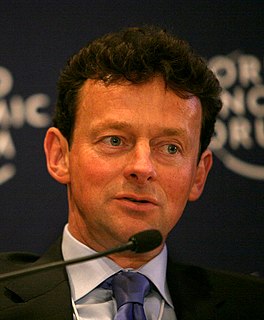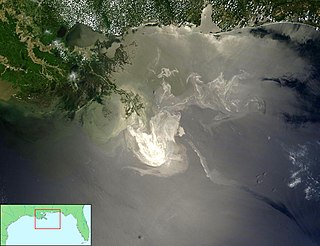Related Research Articles

Taylor Energy was an independent American oil company that drilled in the Gulf of Mexico and was based in New Orleans, Louisiana. The company was founded in 1979 by Patrick F. Taylor. Following his death in 2004, his wife Phyllis Taylor assumed ownership and became the chairman and CEO—making her the wealthiest woman in Louisiana. Taylor actively supported the reconstruction of New Orleans after its destruction during Hurricane Katrina.

Anthony Bryan Hayward is a British businessman and former chief executive of oil and energy company BP. He replaced John Browne, Baron Browne of Madingley, on 1 May 2007. His tenure ended on 1 October 2010 when he was replaced by Bob Dudley following the Deepwater Horizon oil spill. He has been chairman of Glencore Xstrata since May 2014.

The U.S. offshore drilling debate is an ongoing debate in the United States on whether or not, the extent to which, in which areas, and under what conditions, further offshore drilling should be allowed in U.S.-administered waters.

McDonogh 35 Senior High School is a charter public high school in New Orleans, Louisiana. It is a part of New Orleans Public Schools and InspireNOLA charter operator. The school was named after John McDonogh.

William Harold Nungesser, is an American politician serving as the 54th Lieutenant Governor of Louisiana.

Carl Joseph Barbier is a United States District Judge of the United States District Court for the Eastern District of Louisiana.

The Deepwater Horizon oil spill was an industrial disaster that began on 20 April 2010, in the Gulf of Mexico on the BP-operated Macondo Prospect, considered to be the largest marine oil spill in the history of the petroleum industry and estimated to be 8 to 31 percent larger in volume than the previous largest, the Ixtoc I oil spill, also in the Gulf of Mexico. The U.S. federal government estimated the total discharge at 4.9 million barrels. After several failed efforts to contain the flow, the well was declared sealed on 19 September 2010. Reports in early 2012 indicated that the well site was still leaking. The Deepwater Horizon oil spill is regarded as one of the largest environmental disasters in American history.

The Deepwater Horizon drilling rig explosion was the April 20, 2010, explosion and subsequent fire on the Deepwater Horizon semi-submersible mobile offshore drilling unit, which was owned and operated by Transocean and drilling for BP in the Macondo Prospect oil field about 40 miles (64 km) southeast off the Louisiana coast. The explosion and subsequent fire resulted in the sinking of the Deepwater Horizon and the deaths of 11 workers; 17 others were injured. The same blowout that caused the explosion also caused an oil well fire and a massive offshore oil spill in the Gulf of Mexico, considered the largest accidental marine oil spill in the world, and the largest environmental disaster in U.S. history.
The following is a timeline of the Deepwater Horizon oil spill. It was a massive oil spill in the Gulf of Mexico, the largest offshore spill in U.S. history. It was a result of the well blowout that began with the Deepwater Horizon drilling rig explosion on April 20, 2010.
The civil and criminal proceedings stemming from the explosion of Deepwater Horizon and the resulting massive oil spill in the Gulf of Mexico began shortly after the April 20, 2010 incident and have continued since then. They have included an extensive claims settlement process for a guilty plea to criminal charges by BP, and an ongoing Clean Water Act lawsuit brought by the U.S. Department of Justice and other parties.
This article covers the effect of the Deepwater Horizon disaster and the resulting oil spill on global and national economies and the energy industry.
On May 30, 2010 a 6-month moratorium on all deepwater offshore drilling on the Outer Continental Shelf was declared by U.S. Secretary of the Interior Ken Salazar. The limitation was in response to the Deepwater Horizon oil spill which occurred in the Gulf of Mexico.
Following is a timeline of the Deepwater Horizon oil spill for June 2010.
Following is a timeline of the Deepwater Horizon oil spill for July 2010.
Following is a Timeline of the Deepwater Horizon oil spill for May 2010.
Reactions to the Deepwater Horizon oil spill from various officials and interested parties ranged from blame and outrage at the damage caused by the spill, to calls for greater accountability on the part of the U.S. government and BP, including new legislation dealing with preventative security and clean-up improvements.
Following is a timeline of the Deepwater Horizon oil spill for August 2010.
The Deepwater Horizon Oil Spill Trust is the $20 billion trust fund established by BP to settle claims arising from the Deepwater Horizon oil spill. The fund was established to be used for natural resource damages, state and local response costs and individual compensation. It was established as Gulf Coast Claims Facility (GCCF), announced on 16 June 2010 after meeting of BP executives with U.S. President Barack Obama. In June 2012, the settlement of claims through the GCCF was replaced by the court supervised settlement program.
The Deepwater Horizon oil spill was discovered on the afternoon of 22 April 2010 when a large oil slick began to spread at the former rig site. According to the Flow Rate Technical Group, the leak amounted to about 4.9 million barrels of oil, exceeding the 1989 Exxon Valdez oil spill as the largest ever to originate in U.S.-controlled waters and the 1979 Ixtoc I oil spill as the largest spill in the Gulf of Mexico. BP has challenged this calculation saying that it is overestimated as it includes over 810,000 barrels of oil which was collected before it could enter the Gulf waters.

The Deepwater Horizon oil spill occurred between April 10 and September 19, 2010 in the Gulf of Mexico. A variety of techniques were used to address fundamental strategies for addressing the spilled oil, which were: to contain oil on the surface, dispersal, and removal. While most of the oil drilled off Louisiana is a lighter crude, the leaking oil was of a heavier blend which contained asphalt-like substances. According to Ed Overton, who heads a federal chemical hazard assessment team for oil spills, this type of oil emulsifies well. Once it becomes emulsified, it no longer evaporates as quickly as regular oil, does not rinse off as easily, cannot be broken down by microbes as easily, and does not burn as well. "That type of mixture essentially removes all the best oil clean-up weapons", Overton said.
References
- ↑ Rizvi, Sarah (November 16, 2019). "Microsoft to open AI R&D center for energy industry". ChannelME. Dubai, United Arab Emirates. Retrieved April 7, 2020.
- ↑ Agboola, Adedammola (June 25, 2018). "Exec who oversaw BP's oil spill in the Gulf joins INROADS board of directors". Black Enterprise. New York City, New York. Retrieved April 7, 2020.
- ↑ CNN Wire Staff (2010-06-03). "BP: We'll pay the bill for now". Cable News Network. Turner Broadcasting System, Inc. Retrieved 30 June 2010.
- 1 2 Rose, Julie (July 1, 2010). "Darryl Willis: BP's Unexpected Public Relations Man". NPR. Retrieved 2010-07-10.
- ↑ Rioux, Paul, West Bank bureau (2010-06-27). "New Orleans native gives BP a friendlier face". NOLA.com. Archived from the original on 2013-04-11. Retrieved 2010-07-10.CS1 maint: multiple names: authors list (link)
- ↑ Darryl K. Willis profile on Facebook
- ↑ Carmichael Bayne, Sandra. "Katrina can't dampen Louisianans' wedding". The Martha's Vineyard Times. Archived from the original on 2011-09-27. Retrieved 2010-07-10.
